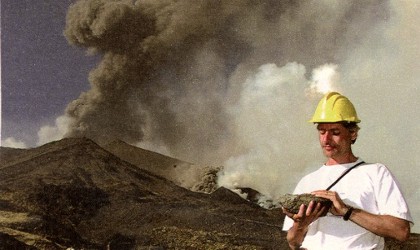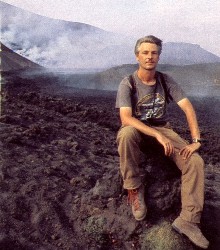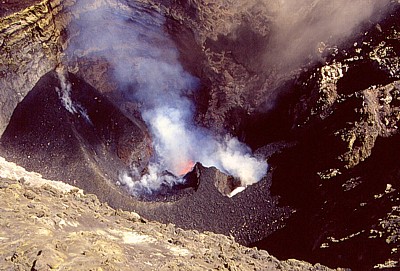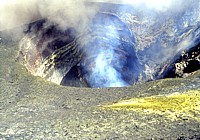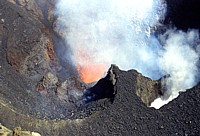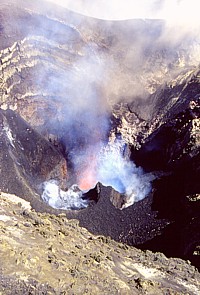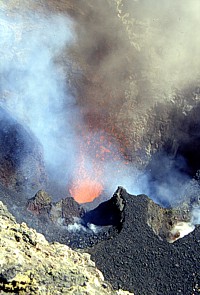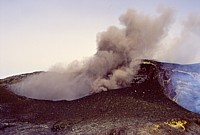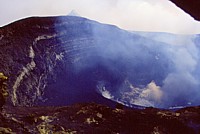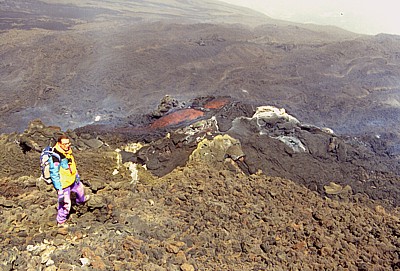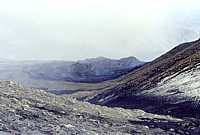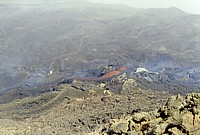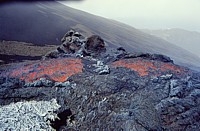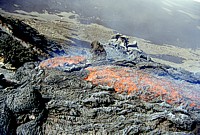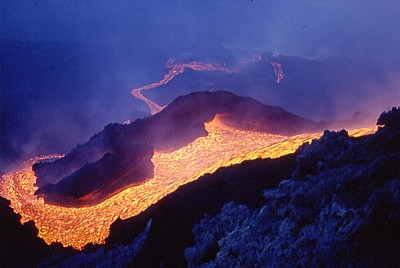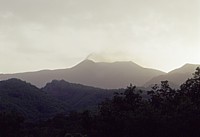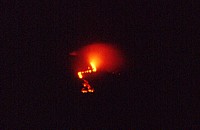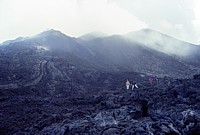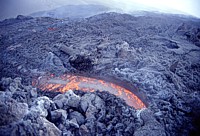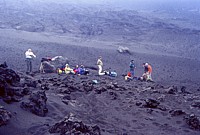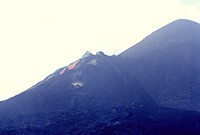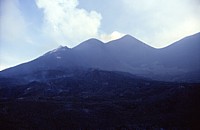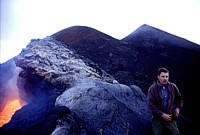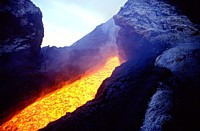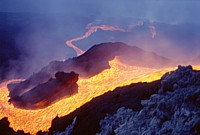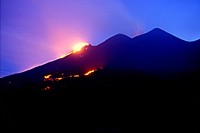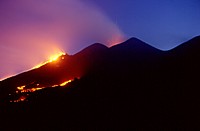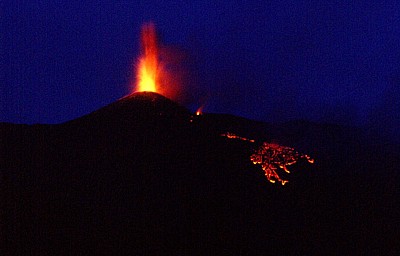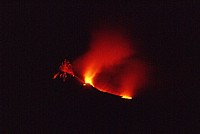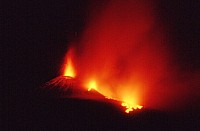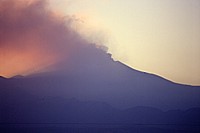| Etna
index |
||
| Geology | Geological history | Cones and craters |
| Eruptive characteristics | Eruptions before 1971 | Eruptions since 1971 |
| Etna and Man | References | Web sites |
| Weather forecasts | FAQ | Latest news |
Etna
photo gallery: 2001
Etna makes the news
![]()
The year 2001
marked the final part of the long-lived summit eruptions that began five
years earlier, and the first flank eruption of Mount Etna since 1991-1993.
Following a long, slow build-up between January and June, the Southeast
Crater returned to producing lava fountains in June and produced fifteen
episodes of lava fountaining and lava emission for about six weeks. Then
a dramatic seismic crisis (with more than 2500 events in four days) heralded
the flank eruption, which began on 17 July and lasted until 9 August.
That eruption was one of the most complex seen at Etna during the past
hundred years, with a total of seven eruptive fissures erupting simultaneously,
two different types of magma being emitted, and violently explosive activity
at one of the newly formed vents. Rarely has an eruption anywhere in the
world been such a media spectacle. Journalists from all over the world
flocked at the volcano to follow the events and interview an incredible
quantity of true or self-declared Etna experts and show them in action
near the eruptive vents. While some news reports declared already the
partial destruction of the town of Nicolosi, which was in the path of
the largest lava flow (but ran a low risk of ever being touched by it),
the eruption caused serious damage to the tourist complex around the Rifugio
Sapienza. The most important loss was that of the arrival station of the
cable car, near the end of the most dramatic phase of the eruption.
Following the July-August flank eruption, Etna fell in deep silence. Yet
everybody was sure that soon the volcano would return on the stage, which
it did ten months later, in the summer of 2002. And soon we would see
that it had not lost the least bit of its potential to take us by surprise.
Part 1: Before the flank eruption, January-June 2001
I made two visits to the summit area of Etna during the period between January and June 2001, one on 25 March and the other two months later. Slow extrusion of lava had begun from a vent on the north-northeastern side of the Southeast Crater (the so-called "Levantino") in mid-January 2001 and continued at a fairly low rate for three months. Mild explosive activity also resumed in January at the Bocca Nuova, following about one month of relative quiet. During the 25 March visit, Strombolian explosions were observed at the Bocca Nuova, and non-explosive lava emission occurred from two vents at the "Levantino".
View
into the southeastern pit of the Bocca Nuova, on 25 March 2001.
Mild Strombolian activity is seen in one of several vents on the
bottom of the pit, about 50 m below its rim |
Giuseppe
"Pippo" Scarpinati standing above the two effusive vents
at the Levantino, on the north-northeastern flank of the Southeast
Crater cone, 25 March 2001. Lava emission is entirely non-explosive
but accompanied by a strong hissing noise. Two small lobes of lava
are flowing to the east and west from the vent area, and later both
take a more northeasterly course |
An evening at the Levantino, 23 May 2001
Two months after my previous visit to the summit area, the activity at the "Levantino" and the Southeast Crater has increased notably. Lava emission from the Levantino is much more voluminous, and accompanied by small Strombolian bursts from the summit vent of the Southeast Crater. This is the kind of show everyone would like to see on Etna, but this is going to last only 2 further weeks, after which the Southeast Crater will once more become much more violent. That marvellous evening of 23 May 2001 I was accompanied by a group of hikers from the Open University Geological Society (Mainland Section) and three French hikers, who lived unforgettable an unforgettable experience.
Prospects
for a splendid new tourist season in the summer of 2001 lie in this
beautiful lava flow cascading down the eastern flank of the Levantino
on 23 May 2001. Like in 1999, the presence of a persistent lava
flow relatively easy to reach on foot seems to grant a huge flux
of tourists, and mountain guides build a narrow, winding footpath
from the Piano delle Concazze right to the source of this lava flow.
However, in the end very few tourists will see the marvellous display,
before more violent activity at the Southeast Crater will render
close visits impossible |
And once more lava fountains, 13 June 2001
In
early June 2001, the activity of the Southeast Crater enters into yet
another phase of episodic lava fountaining. Compared to the numerous lava
fountains of the year 2000, these events initially appear to be less intense,
and they occur at intervals of 2 to 5 days over a period of about 6 weeks.
However, nearly the same sequence as in those earlier events is observed:
(1) slow lava effusion begins from the Levantino, and gradually increases
over several hours, (2) Strombolian activity begins at the summit vent
of the Southeast Crater, (3) lava fountaining begins at the Levantino
(sometimes also at several vents upslope from the Levantino) and then
also at the summit of the crater; intense activity continues for about
one hour, (4) the activity gradually decreases at all vents, and the ash
content in the emissions from the summit vent increases temporarily. During
some of the intervals between eruptive episodes, lava emission from the
Levantino continues at a slow rate. Differently from the eruptive episodes
in 2000, these did not involve any activity from the southern flank of
the Southeast Crater cone.
The latest of the lava fountains in this period occurs on the early morning
of 17 July 2001. Then, a few hours later, new vents open at the base of
the Southeast Crater, and the first flank eruption since 1991-1993 begins...
Day
breaks on 13 June 2001, and a paroxysmal eruptive episode at the
Southeast Crater is about to end. A multilobate lava flow that has
been emitted from the Levantino vent (visible as a small glowing
spot in the center of the image) and is slowly cooling as the supply
has ceased, and isolated but strong Strombolian bursts continue
at the summit vent of the Southeast Crater, reaching heights of
300-400 m. |
Part 2: The flank eruption of July-August 2001
Return to the Etna photo gallery
Copyright © Boris Behncke, "Italy's Volcanoes: The Cradle of Volcanology"
Page set up on 23 November 2003

